مـِگالودون
| Megalodon | |
|---|---|
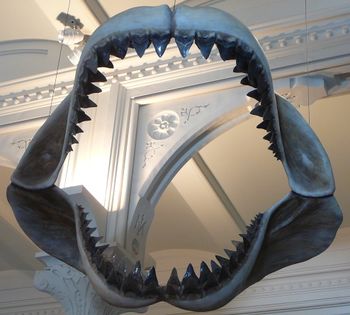
| |
| Model of megalodon jaws at the American Museum of Natural History | |
| التصنيف العلمي | |
| أصنوفة غير معروفة (أصلحها): | Carcharocles |
| Species: | Template:Taxonomy/CarcharoclesC. megalodon
|
| Binomial name | |
| Template:Taxonomy/CarcharoclesCarcharocles megalodon | |
| Synonyms[2][3][4][5] | |
|
List of synonyms
| |
المـِگالودون (Carcharocles megalodon)، يعني "سِن كبير" هو نوع منقرض من القروش عاش تقريبًا في الفترة من 23 إلى 2.6 مليون سنة، خلال الإيوسين المبكر إلى نهاية الپليوسين. كانت هناك بعض المناظرات حول تصنيف الميجالودون: تحجج بعض الباحثين بأنه كان من فصيلة اللمنيات ويرتبط ارتباط وثيق بالقرش الأبيض الكبير، بينما تحجج آخرون بأنه ينتمي إلى فصيلة الأوتودونتيات المنقرضة، وحاليًا هناك شبه إجماع على الرؤية الثانية صحيحة. إلا أن تحديد جنسه لا يزال موضع نقاش، حيث يضعه الكُتَّاب إما في الكارتشيروكليس (Carcharocles)، الميجاسيلاكس (Megaselachus)، الأوتودس (Otodus)، أو البروكارتشيرودون (Procarcharodon).
يقترح العلماء أن الميجالودون كان يشبه نسخة ممتلئة من القرش الأبيض الكبير، على الرغم من أن شكله ربما كان مماثلًا للقرش المتشمس أو قرش الرمل الببري. وباعتباره واحد من أكبر وأقوى الحيوانات المفترسة التي عاشت على الإطلاق؛ فإن بقايا حفريات الميجالودون تشير إلى أن هذا القرش العملاق وصل طوله إلى 18 متر (59 ft). ويمكن أن تصل قوة عضّة فكَّيه الكبيران من 108,514 إلى 182,201 نيوتن (11,065 إلى 18,579 كجم؛ 24,395 إلى 40,960 رطل). أسنانه كانت سميكة ومتينة، بُنيَت من أجل انتزاع الفريسة وكسر العظام.
ربما كان للميجالودون تأثير عميق على بنية المجتمعات البحرية، ويشير السجل الأحفوري إلى أنه كان له توزيع عالمي. وربما استهدف فرائس كبيرة مثل الحيتان وزعنفيات الأقدام والسلاحف العملاقة. وكان الصغار يسكنون المياه الساحلية الدافئة حيث تغذوا على الأسماك والحيتان الصغيرة. وعلى عكس القرش الأبيض الكبير الذي يهاجم الفريسة من الجانب السفلي الأملس، ربما كان الميجالودون قد استخدم فكَّيه القويان لاختراق تجويف الصدر وخرق القلب والرئتين لفريسته.
وقد واجه الميجالودون منافسة من الحيتان آكلة الحيتانيات، مثل الليڤياتان والحيتان القاتلة القديمة (Orcinus citoniensis) والتي ربما ساهمت في انقراضه. وبما أنه كان يفضل المياه الأكثر دفئًا فيُعتقَد أن التبريد المحيطي المرتبط ببداية العصور الجليدية، مقرونًا بانخفاض مستوى سطح البحر وما نتج عنه من فقدان مناطق حضانة مناسبة، ربما ساهما أيضًا في انخفاض أعداده. إن الانخفاض في تنوع الحيتان البالينية والتحول في توزيعها نحو المناطق القطبية ربما قلل من مصدر الغذاء الرئيسي للميجالودون. ويبدو أن انقراض القرش يؤثر على الحيوانات الأخرى؛ على سبيل المثال، إزداد حجم الحيتان البالينية بشكل ملحوظ بعد اختفاء القرش.
التبويب
التسمية

According to Renaissance accounts, gigantic, triangular fossil teeth often found embedded in rocky formations were once believed to be the petrified tongues, or glossopetrae, of dragons and snakes. This interpretation was corrected in 1667 by Danish naturalist Nicolas Steno, who recognized them as shark teeth, and famously produced a depiction of a shark's head bearing such teeth. He described his findings in the book The Head of a Shark Dissected, which also contained an illustration of a megalodon tooth.[6][7][8]
التطور
|
| ||||||||||||||||||||||||
| Relationship between megalodon and other sharks, including the great white shark (Carcharodon carcharias)[9] |
علم الأحياء
المظهر

One interpretation on how megalodon appeared was that it was a robust-looking shark, and may have had a similar build to the great white shark. The jaws may have been blunter and wider than the great white, and the fins would have also been similar in shape, though thicker due to its size. It may have had a pig-eyed appearance, in that it had small, deep-set eyes.[10]
الحجم
إحصائيات

التقديرات
الأسنان وقوة العض
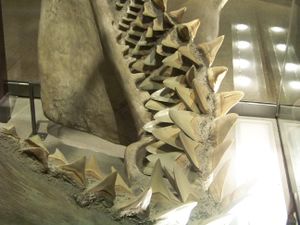
التشريح الداخلي
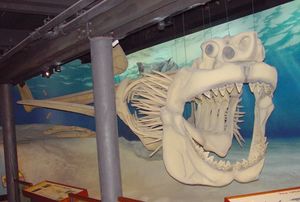

علم الأحياء العتيق
النطاق والموئل
مواقع الحفريات
Megalodon had a global distribution and fossils of the shark have been found in many places around the world, bordering all oceans of the Neogene.[11]
علاقات الافتراس
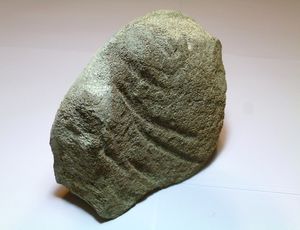
التنافس
أماكن الحضانا
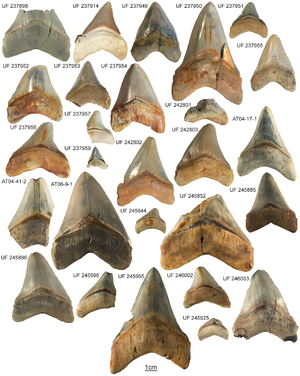
تغير النظام البيئي
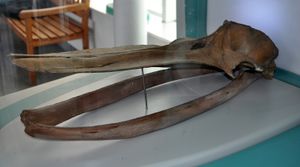
In popular culture

انظر أيضاً
References
- ^ خطأ استشهاد: وسم
<ref>غير صحيح؛ لا نص تم توفيره للمراجع المسماةagassiz1833 - ^ "Otodus (Megaselachus) megalodon (Agassiz, 1837)". SharkReferences.com. Retrieved 24 October 2017.
- ^ Eastman, C. R. (1904). Maryland Geological Survey. Vol. 2. Baltimore, Maryland: Johns Hopkins University. p. 82.
- ^ خطأ استشهاد: وسم
<ref>غير صحيح؛ لا نص تم توفيره للمراجع المسماةcappetta - ^ Hay, O. P. (1901). "Bibliography and Catalogue of the Fossil Vertebrata of North America". Bulletin of the United States Geological Society (179): 308.
- ^ Haven, Kendall (1997). 100 Greatest Science Discoveries of All Time. Westport, Connecticut: Libraries Unlimited. pp. 25–26. ISBN 978-1-59158-265-6. OCLC 230807846.
- ^ Kuang-Tai, Hsu (2009). "The Path to Steno's Synthesis on the Animal Origin of Glossopetrae". In Rosenburg, G. D. (ed.). The Revolution in Geology from the Renaissance to the Enlightenment. Vol. 203. Boulder, Colorado: Geological Society of America. ISBN 978-0-8137-1203-1. OCLC 608657795.
- ^ Eilperin, J. (2012). Demon Fish. Pantheon Books. p. 43. ISBN 978-0-7156-4352-5.
- ^ خطأ استشهاد: وسم
<ref>غير صحيح؛ لا نص تم توفيره للمراجع المسماةFSP - ^ خطأ استشهاد: وسم
<ref>غير صحيح؛ لا نص تم توفيره للمراجع المسماةG - ^ أ ب قالب:Fossilworks
- ^ خطأ استشهاد: وسم
<ref>غير صحيح؛ لا نص تم توفيره للمراجع المسماةPimiento2016 - ^ خطأ استشهاد: وسم
<ref>غير صحيح؛ لا نص تم توفيره للمراجع المسماةLV - ^ خطأ استشهاد: وسم
<ref>غير صحيح؛ لا نص تم توفيره للمراجع المسماةcollareta2017
Further reading
- Dickson, K. A.; Graham, J. B. (November–December 2004). "Evolution and consequences of endothermy in fishes". Physiological and Biochemical Zoology. 77 (6): 998–1018. doi:10.1086/423743. PMID 15674772.
- Kent, Bretton W. (1994). Fossil Sharks of the Chesapeake Bay Region. Columbia, Md.: Egan Rees & Boyer. ISBN 978-1-881620-01-3. OCLC 918266672.
External links
- Paleontological videos
Note: Flash Player is required to view the content below.
- Paleontologist Mark Renz shows one of the largest megalodon teeth discovered at YouTube
- Shark Week Special on megalodon with Pat McCarthy and John Babiarz at YouTube with comments on its extinction.
- Megalodon fossil teeth show evidence of 10-million-year-old shark nursery at YouTube
- Expert view: information about megalodon at YouTube (featuring expert Dana Ehret)
- Lamniform sharks: 110 million years of ocean supremacy at YouTube (featuring expert Mikael Siverson)
- The Rise and Fall of the Neogene Giant Sharks at YouTube (featuring expert Bretton Kent)





